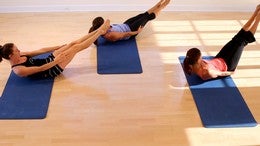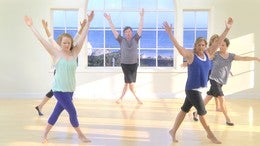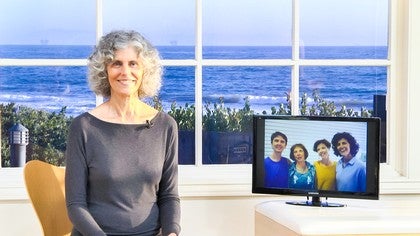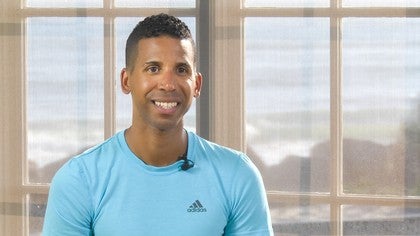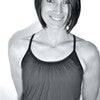Discussion #1913
Michael and Ton on Romana
Description
About This Video
Transcript
Read Full Transcript
I first learned about Romana in the early eighties. I was a dancer/performer, and I'd broken my ankle, and a physical therapist had said, "Okay, to rehab, you should do either Zena Rommett floor barre, or do Pilates with Romana." And I think he tossed out another name. I don't even remember the name, but I remember Romana's name. But at the time, dancers didn't make that much money. So there was Zena Rommett floor barre where you could buy a class card and get a whole bunch of classes, or you could do a Pilates session, which was private at that time. And so of course I went with the Zena Rommett floor barres, so missed opportunity for Romana, but being a performer in New York, Pilates was always there. There was always some performer in a show sitting there in the corner doing the hundred.
So you were aware of it existing and people saying how good it was for the body, but it never really, I just thought, "Well, that's interesting." But you know, like I said, it just wasn't for me at that time. And so this went on for a decade. Even over in Europe in the late eighties, early nineties, doing Cats over in Europe, performers from London, which would have been at Pineapple Studio, I think that's where they were doing Pilates. And people from New York, because at that time in Europe, there weren't a lot of performers that were Europeans, because they didn't really have a strong core of dancer/singers over there, we went over for Cats. So there would be dancers doing it, and then finally in the early nineties, there was a performer who had since become dance captain for Cats. There was a performer, Sarah Smolan, who was hardly ever injured, who had started the certification program with Romana in the early nineties, but then stopped to go do Cats, but she was never injured.
Her core was incredibly strong, and she did the whole Mat. And so that's when she taught both Ton and I the Mat and tell us about this crazy lady in New York that taught Pilates. And there were a couple of other crazy ladies too, but Carola didn't really teach too much at the time, and there was Kathy Grant. But unless you wanted to go back to college, which neither one of us wanted to do, it wasn't a choice for us. So we kept that sort of in the back of our mind. And fast forward a few years later, we quit Cats and I went to New York to study with Romana. My first impression of Romana was that she was extremely energetic and very commanding in a way, because the first time we went in to Drago's, the layout was that you could not really see the Pilates equipment right when you walk in. So you walk in and it was a little couch and you walk to the side, to the reception desk. And then there was this space that opened up. You and the Reformers were all on the back wall, and in front of you were the Reformers, the parallel bars from the gymnastics that they were still doing there, the big mat, the rings.
And I remember going in and Romana being on one of the back Reformers, and there was just this presence in the room and it was like, it was obvious that she was in charge of the realm. It was like, even though she was not in charge of like in a screaming kind of way, there was this, she's here kind of thing. So that was my first impression. And then we just walk. We just looked around and go like, "Are we sure we're in the right place?" Because we had heard of like, you know, you have to be with Romana. So we expected a very sleek kind of studio when it was anything but kind of thing. So it was very, people were swinging on the rings, and people are doing somersaults on the big mat because it was not individual mats, it was just one big huge mat, and people were using the equipment swinging everywhere and we'd go like, "This is really cool, but this is kinda crazy." So that was sort of like my first real impression of her. And then, she just noticed us, and she walked over and basically said something to the extent of like, "How can I help you gentlemen?"
And we were like, "Well, we're here for Romana. We want to be teachers." So she was like, "Well, I'm Romana." So we talked a little bit and it was very relaxed, like where you're from, who did you study with, that kind of stuff. And right away she loved the fact that I was Dutch, or still am Dutch. But that we had lived in Europe and came from Europe and you know, that we had just quit our performing career and that kind of stuff. And so I think that was an instant bond, our first connection right away. And then she talked, and we talked, and she was like, "Well that's fine. I'll work with you and we'll organize this session. Be here tomorrow at seven." And we just laughed. We were like, "We don't do seven." You know, after being in theater and having late nights, and our natural rhythm was just not getting up that early. And she crossed her arms and looked us up and down and said, "Fine. Be here whenever." And we stop and you know, we were like, "Okay, we'll be here whenever I guess." So we went to the front desk and made an appointment and I believe it was like nine, eight or nine. It wasn't seven.
The next day we came back about probably, I want to say probably a half hour before our session, 15 minutes before, got changed, and she was ready for us. She put us on the Reformer and killed us. She was like, she was going to make her point. And she did make her point. And I think part of it, like talking about it, was that she knew where we were coming from. She knew our background from our talk. And I also think that she knew that once she gets you on the Reformer, once she gets you interested, she'll be able to manipulate you to come whenever she wants you to come. I mean, Romana was a very good manipulator in that way, to get you to do what she wanted you to do thinking it was your idea, you know what I mean? So we started off at eight, and we did our session, and at the end of the session she said, "Fine, I'll work with you and you can become teachers, but you do it my way." And that meant something to the effect of like, "You do it the way I was taught by Joe." And that was then considered, I think officially it was independent study, independent study that was the quote. Which meant she took us under her wing.
We only studied with her. We were not allowed to study with anybody else. We paid her directly. We had sessions at least three times a week, sometimes more, and she basically told us, "I don't want going to get any manuals. You're not going to get any workshops, no seminars. You're not logging in any hours. You're with me. Only with me.
You do what I tell you to do and I'll tell you when you're ready." And we had saved money while we were in musical theater in Europe, and we basically had already sort of decided we'd take a year off and we were just going to take this year and totally focus on this thing called Pilates and becoming teachers. We should add to it too that Romana asking us to start to do it without books and without manuals meant nothing to us. We didn't know there was a book, we didn't know there was a manual. So for us it was like, fine, you deal with the book. I mean, that's how we sort of assumed you learned anyway, because it's how we learned shows. So the only thing we had was this little blue card, not very big. It had the whole Mat in one order. It even said Contrology. And on the back it had the Mat exercises.
So this was our manual along with lots of pictures of Joe. Well not a lot, but pictures of Joe with the chart of the exercises going through the order so you could check as we were learning to make sure you sort of saw the order. And that was it. And she encouraged us. We took tons of notes. We have tons of notebooks. She thought the way you learned the whole method was to experience through watching, through doing it. The way she learned from "Uncle Joe" as she put it. And for Romana, Pilates was also family. I think that Uncle Joe was quite popular with dancers like in the 30's and 40's. Balanchine, there's all those stories out there of him sending the dancers over and going, "Go over to Uncle Joe. He'll fix you and get you back on stage." But Romana with Joe, when she talked about Joe, you got the impression that there really was a closeness. A family connection. There was a protection. It really was like Uncle Joe. So with that in mind, she was very protective of the method and really wanted to teach it and pass it down. And for her, the method wasn't ever about the exercises.
And I think a lot of people think that traditional Pilates is all about the execution of the exercises are as we like to refer to it, "the performance artiste" for Pilates. But it really wasn't about that. Romana was about the essence of what the method did for you. It helps you walk better. It helps you be a better human. It helps you breathe better. It helps everything you do. And she used to always say, Pilates is not about the exercises. It's about what the exercises do for your body when you're not exercising.
So with that in mind, what was really cool at the time, even though we didn't know it was really cool, we just thought it was normal, Romana taught normal clients. By the time we quit when we were teacher trainers, there were 30 or 40 people crammed in that studio and she was only teaching apprentices. But at this time, there was just a handful of clients. There were normal people there and we nicknamed them. There was Miss Underpants, this woman who would wear this French cut leotard and her white bloomers would show through. There was Little Tiny Sylvie, Sylvia, who was this frail little old woman. And to give you the broad spectrum of what Pilates meant to Romana, is poor little Sylvia would come in and she was just this frail thing. Romana would set her on the Cadillac and she would do what Romana called the TV exercises, you know, just barely lifting her leg and then maybe doing a little side band. And after 15 minutes, Sylvia was huffing and puffing and Romana would go, "I think you've had an elegant sufficiency, Darling."
And that was one of her favorite things. And she would send her on her way and charged her for the hour, smart woman. But that's what Pilates is to Romana. What that meant to her was you did 100% whether you were a little tiny Sylvia, because then the next hour she might've had a Martha Graham dancer, a principal dancer in there who was sweating after two minutes, and do every advanced headstand, backbend you could think of, and a walk off on the Cadillac. It was crazy. But both were 100% and that's Pilates. It goes from the very simple Pre-Pilates exercises, if that's what you want to call it, all the way to the super advanced. There was that wide spectrum, and we got to experience that with her because she taught normal clients. And at the time we were apprentices. It was a very small group of people. Like I said, some days it was only Ton and I in the studio.
And I think you can see by some of the pictures we brought for you, it's not crowded. And later on it became, 30, 40 people crammed in the room. I mean it was just crazy. But at the time we were there as apprentices, there were only normal clients and by the end when we quit with Romana, she was only teaching apprentices and teaching the super advanced. So people didn't really get the essence of the whole method in the sense of really being able to watch her. There were doctors coming in, even at that time they had great interest in the whole Pilates method. And there were news interviews. So it was starting just to build, and Pilates wasn't really a household name yet.
It was just something that was sort of fun, and the clients were great. There were clients that worked with Joe and Clara and we got to work with a lot of those clients. And after a while Romana would entrust you with her clients, and she would sort of supervise, keep an eye on you. And then that way she could do one client and have another one booked. Meanwhile, we didn't get paid, but she got double the money for the fact that we were teaching for her for free, which was fine because it was great experience. I think Romana was right. The way she taught us a true apprenticeship was the way to really learn this method. And I still really think it is the best way. But nobody can afford to take a year off.
Nobody has the luxury of being a small group of two or three with this incredible master teacher. So you can't learn that way. But thank God we learned that way. But I think it really shows you the group of apprentices that came out at the time that we were all there. It's Brooke Siler, Alycea Ungaro. They all were apprentices at the same time. And I think that group, you can see the strong understanding that we all got from that kind of intense training and with normal clients. Because by the end, like I mentioned earlier, Romana and Sari were both only teaching the apprentices. People didn't get to see the little Sylvie's very often because she handed those down to the apprentices and the other people at the studio. And she also required you to know it from a to z. You know what I mean?
It was not enough to know the order or to know this. You needed to be able to deal with all the different issues, all the different personalities. And that was a part of what she saw set as a part of being able to run your business is to be able to deal with difficult clients. And there were some difficult clients there that had strong personalities and some of them did not want to be taught by an apprentice. They wanted Romana, they had paid for Romana. That's what they wanted. And then you're standing there and you're like, "Yeah, sorry you got me now." And they were not happy. And part of her training program was how do you deal with that as an instructor, how do you get your client to do what you want them to do?
How are you able to convince them that you are the best for them right now? So a lot of times people say that she just did things, and I think she was a lot more calculated and much smarter than just that. She never puts you in a situation with any kind of client or issue that she did not know you could handle, and that it would be safe. But it might be a situation that you as an instructor or apprentice were uncomfortable in because you didn't want to deal with it and she forced you to deal with it while making you a better instructor in the meantime. And I think part of it also was, it was not about, like Michael said about the exercises, but in a way it was also not only about Pilates. Pilates was a part of your day, and when that was over, then it was over. You know what I mean? It was like what Joe states of how Pilates is supposed to be done.
So what you want to do, you can do without injuries or with more energy or whatever. It was not this holistic kind of thing in that way. It was more like you do Pilates as hard as you can, as good as you can. Like Michael said, if you're 100%, and Romana used to say you get out of it what you put into it, you know. If you don't put it in, nothing will come out. But then when it was over, then it was over. And then you were supposed to, she would kick you out of the studio and say to go to the park, go and see a show, do something fun, you know. Don't, go home and go only over your notes and go over every client again and try to analyze everything you did.
It was like, enjoy life as much as you enjoy Pilates. And that was very important for her, I think. She enjoyed family, friends, and everything like that, and it needed to be equal for her. Play time, work time, family time. You need to make time for each one of them, and each one of them you need to do 100%. So when you do Pilates, that's what you do. And when Pilates is over and you go with your family, then it's family. It's nothing to do with Pilates, it's family. She really taught you life in a way through Pilates, if that makes sense. But she was also an incredible motivator. Oh God, she could teach anybody. And she had this ability to make you, how would you say, think you could do anything with very few words. She always believed, just don't over-correct. Just one correction is all you should ever give.
And what she would do is she would just make you think that you could do anything. You would be totally doing somersaults. I mean, I had come to Romana, I guess I have to backtrack a bit. A lot of the sessions we had were duets, and I had come with a back injury. I had a herniated disc and had been paralyzed from the knee down like a couple of years earlier. And Ton was totally healthier. Romana would do duets with us and have us both working at 100% during the same exercise, but modified or a variation for me because of the issues that I had. That first session with Romana, to go back to that intuitive part, I told her about my back because that was a new injury.
I laid down on the Reformer and she was like, "What's wrong with your ankle?" And I was like, "Nothing's wrong with my ankle." She says, "You did something with your ankle. There's misalignment." And I was like, "Wow. Well, 20 years ago I did break my ankle and it was screwed back together." And she goes, "Well, I can see it." And that was it. And the session went on and it was the same with you. She had seen your calf? Yeah, I tore my calf. And she picked up on it. But it was also one of the things that she always said. She said the client will always lie, but the body never lies. Right. And she said you had to fill out the sheet, or you had to talk to them and listen to what they say. But she said don't trust them because they lie down, like either on the Reformer or wherever you start, she said that's the body that's in front of you and that's what you're going to have to work with and you're going to have to observe them because they will never tell you all the stuff that's going on. And part of it is like with Michael, you forget 20 years after an injury and you think you're in balance, you think you're still living. You are jumping and dancing and it doesn't bother you, but still it showed up.
And that's part of the magic of the method in a way. And a part of her, of being able to see that and catch that, she was unlike anybody else. I mean, she just could motivate you to do anything and get you to believe in yourself that you could do anything. That's how she handled every session. That's how she handled people just in general and in life. And I think that's why we're just one pair of guys, and a whole succession of all these people that have such a close relationship with her because she had close relationships with hundreds of people. She made everybody feel special so everybody felt like they were the chosen one.
They were special. And yes, you were all special. But she made everybody feel that way. That was one of her gifts as a teacher. Also the fact that she believed what she said. She didn't overcorrect. She would just say drop your shoulder, or lower your hip. She would give you just enough in the correction to get you to find the right muscles in your own body without talking about the muscles to do the exercise or move you to the next level. And I guess what we learned from her too is that she would create a safe atmosphere, but she made you feel it's okay to fail but fail safely. I think it's like, we always looked at it like it's a little child. When a child is learning to walk, you safe proof the house and then you let the kid fall. Also with us, we laughed. I mean, it was just fun. And she used to say, "If you're not having fun, why are you going to do it?
Why are they going to pay you? You want them to pay you, so make it fun. You want them to come back. That's your profession." I also think she liked us from the standpoint of we had professional theater careers and we made a conscious choice to quit that, to give it up and do Pilates for a year. We didn't have any desire to go back to theater at that point. We thought about it, but we didn't know. But I think she respected that. We totally put our life on hold for a year. We stopped. We didn't work. We were fortunate, like Ton said, to have the money to take a year off, rented an apartment in New York, and do only Pilates, which I think most people don't have. But that's what we did. In the summer Romana usually took vacations. So this would've been the summer of '96. She took her usual June vacation, and then she would let the apprentices take over her clients while she was gone. And Sari I think was also gone at the same time.
And she came back from vacation, and I guess checked us out. We didn't know about asking her clients how we did. And she came to us and approached us like, "I think you're ready. I think you're ready to teach." And we were like, "Well, I don't think I'm ready to teach. I really don't know anything." But she was like, "No, no, you're ready." But, and this is where we became familiar with Sean, she said we'd been on independent study, but Sean's not too pleased. First of all, I think she didn't really say because we paid her the money. So she said Sean wanted us to take one of these seminars. And we didn't really know the seminars existed. And we sort of did by this time from Brooke and other people, but she said we'd have to come take the seminar. And we were like, fine, we'll take a seminar. And then she said we'd be asked to do this written test. And we agreed. And she said we'd have to pay for this test because we had to pay Sean. And we were still fine.
But that's where Sean came back into the picture. We had not ever seen him. Also at the same time, the same friend Sarah Smolan had given us a combo birthday gift. And my birthday's in April, his is in September. She gave us a free duet session with Bob Liekens. So that's the first time we also met Bob. We knew that he existed, but we hadn't met him in the years that we were there. But if he came into the studio, I didn't know who he was, so I wouldn't have known who Romana was talking to. So that's when we first met Bob, and that's when we first went up to 2121 Broadway to take this test. And Romana also had made a big issue out of it because obviously there was something they didn't like. The fact that we didn't do the seminars. During that seminar, I felt like we were on display for all of Romana's things. It was like we were showing off. I mean, it was like doing a lot of the advanced work, like it was the advanced system review or something like that. But you know, you just got the feeling that, okay, she's trying to prove a point here. Like, my boys without manuals are fine. So we sort of knew what was going on. We took the test for Sean, but that's when we first became connected with Sean because what existed at that time, which we didn't really know about until this time, was there was Drago's, which was downtown and it was Romana's kingdom. Romana's place. She worked there in the mornings and that was a part. Uptown, however, was a studio called 2121, which was called the Pilates Studio. Yeah. Important for a name. Not 2121. That sounds like a nightclub. But anyways, it was connected to Steps. For people that don't know what Steps is,
it was a famous, dance studio where it was an uncommon in 2129 to ride up the elevator with Baryshnikov. I mean, all these stars from the ballet world and musical theater were all there. And it was always in this little typical New York elevator. That's deviating a bit from the story, but that was the Pilates studio at 2121 Broadway. And that's also where Bob Liekens worked uptown with Sean. And in that building in Steps, there was the Pilates Studio, and then across the hall there was the Performing Arts Physical Therapy, which was Sean's practice.
So that was divided by a hallway. So you got off the second floor from the elevator, walked down the hallway, the Pilates Studio on one side, and then there was the PAPT, the Performing Arts Physical Therapy on the other side. So 2121 Broadway. The Pilates Studio was the headquarters for the organization that we were soon sort of learning about that Romana hinted at in our very first meeting. That she and this Sean guy were starting a certification program. And we were like, well, fine, fine. You and Sean, you know, that's fine. But she had said that the 2121 studio was his headquarters, the sort of legal headquarters of the entity the Pilates Studio, which was Romana's thing. And that's how it all sort of ties together. One of the things that happened everyday during our apprenticeship was the day ended with a Q and A.
So before she left, I think we said in the beginning when the elevator opened, there were couches there in front. She would sit there before she would leave and she would say, "What did you learn today?" And you had to say something about what you learned that day. It didn't matter what it was. But she was so smart. So after a while you just go like, "Okay, what am I going to say now?" You know what I mean? Or you get like, "Oh, I'm going to say something that I said a couple of weeks ago." And then, you know, "Oh, when someone has a back problem, you start them on the Reformer." And she would say, "You said that already." And so it became sort of like a game with all kinds of different games going on.
But one of her things was, "If you learn new things every day, you'll be a genius." And then she would say, "I want you to go home and open the dictionary and find a new word that you don't know yet, and I want you to use that word tomorrow." Because she thought that the way you described the exercises had to be uniquely yours.
She didn't want you to be a copycat of her. She wanted you to find your uniqueness as a teacher. So she used to do that. Then we would do "Find the Injury." So she would not tell you what the new client had. Yeah, that was our game. But she played along. She would not tell us what was wrong with this client. And she would give them a session. And by the exercises, the order, the speed, the modifications, the way she put the sessions together, we would try to figure out like, "Oh, this person has a blah, blah, blah, blah, blah." So then after the session was done, we would say, "So this person had a hip problem, right?" And she was going to say either yes or no. But that was sort of like a part of our whole apprenticeship. It was very interactive.
It was very hands on. You dove in, mind, body, and soul. And she demanded that full commitment to it. But this game that we played, it sort of came out of a phrase, because these little meetings were every day from the first day that we started our apprenticeship with her. And then again, we'd ask her questions like, "Okay, well, she has a back injury. So you've started her here, but yesterday you started Rebecca with the back injury here. What is the difference?" And now she goes, "Well, it depends." And that used to just make us mad because it would just depend, you know? And we were like, well that's not an answer. We were like every other Pilates instructor in the beginning.
I want a black and white answer, you know. You don't really understand that Pilates is gray. And so that's when it became like, well, that's the game she's playing with "it depends," and then that's how this game that we would play developed of like, okay, I'm watching her. We would watch her and go, "So what do you think? Do you think that it's actually a hip, or do you think that's a knee?" And then the body would often surprise you of that. It taught us to watch and develop the eye of how you can look at a body. And like she always said, "We teach you what you need to know." And you would see it. And so, she sort of liked the fact that we just played along and made up games that we could play with her in our question and answer period every day. And she would say, "If you learn one thing new every day, you're a genius."
And she was a genius in following that line of like, okay, I see it here, but it's not here. It goes up here. Oh, it's not here. It goes up here. And then she would just go down that path. And she really taught us that like she said, the body doesn't lie. It's right in front of you. Just follow the body and it will teach you. It will tell you everything you need to know.
Pilates Legacy Project: Discussions
Comments
Thank you for your most precious insights
You need to be a subscriber to post a comment.
Please Log In or Create an Account to start your free trial.
